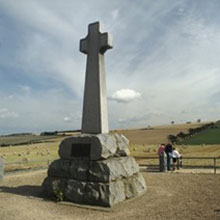History of the Stewarts | Battles and Historic Events
If you are a Stewart Society Member please login above to view all of the items in this section. If you want general information on how to research your ancestors and some helpful links - please look in background information.
If you have a specific question you can contact our archivist.

The Battle of Flodden - Monument
The Battle of Flodden (sometimes known as the Battle of Branxton), was fought in northern England in the late afternoon of September 9th 1513. In the following hours, the fields became the scene of bloody carnage in which an estimated 4,000 Englishmen and 10,000 Scots, including the king and many nobles, lost their lives.
In November 1511, Henry VIII joined the Pope and King Ferdinand of Spain and the Venetians in a Holy League against France. King James IV was now in a very difficult position as he was bound to France by the ´auld alliance´ but also to England by the treaty of 1502 which had promised perpetual peace between the two nations.Therefore when in 1513 King Henry VIII invaded France. In response, King Louis XII requested that his ally, King James IV of Scotland, create a diversion by invading England.
James raised his levies at the end of July. On the 12th August he made a last ditch attempt to salvage the situation with Henry by sending his chief herald Lord Lyon, King of Arms to deliver a final message . This was dismissed and on the 22 of August the Scottish army crossed the Border. Lord Home, with 5000 east march riders rode into Northumberland. He was ambushed there by 1000 English foot under Sir William Bulmer. Despite his losses James marched on into England with his enormous army - said to number up to 30,000. He quickly took Norham, then Etal and Ford. Before artillery, Norham had been able to resist siege for two years, James took it in five days. Legend that James IV spent the night before Flodden at Ford Castle however this seems unlikely as he burnt it.
The size of the Scottish army began to cause problems as men began to drift home to collect the harvest or because of sickness. The levied men were only obliged to give 40 days service and many of them had already served this time. It seems probable that by the start of September James had lost about a third of his army.
The earl of Surrey gathered together an army of 26,000 men and led it into Northumberland to oppose the Scots. Surrey encountered the king James and his army near the village of Branxton.
In the battle that followed,the Scots lost partly because of the ground - they had to cross marshy ground and thus lost the momentum which was important for them. James had trained his spearmen in the latest Swiss pike tactics however using these successfully depended on a great deal of training and strict discipline. These were lacking in the Scots.
The battle was fought over arable fields close to the village and over rough grazing moorland on the hill slopes. Today,there are a series of information boards and marked trails that allow you trace the course of the battle and where the armies stood.
See The Stewarts Vol.24 No 2. pg 99 for a list of the Flodden dead
With thanks to English Heritage and Flodden.net - www.flodden.net
Reference: Flodden Battlefield Trust

